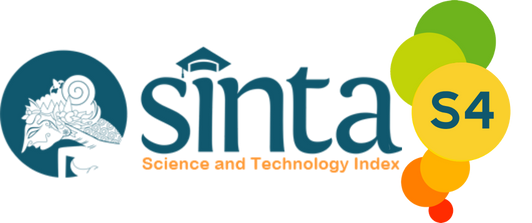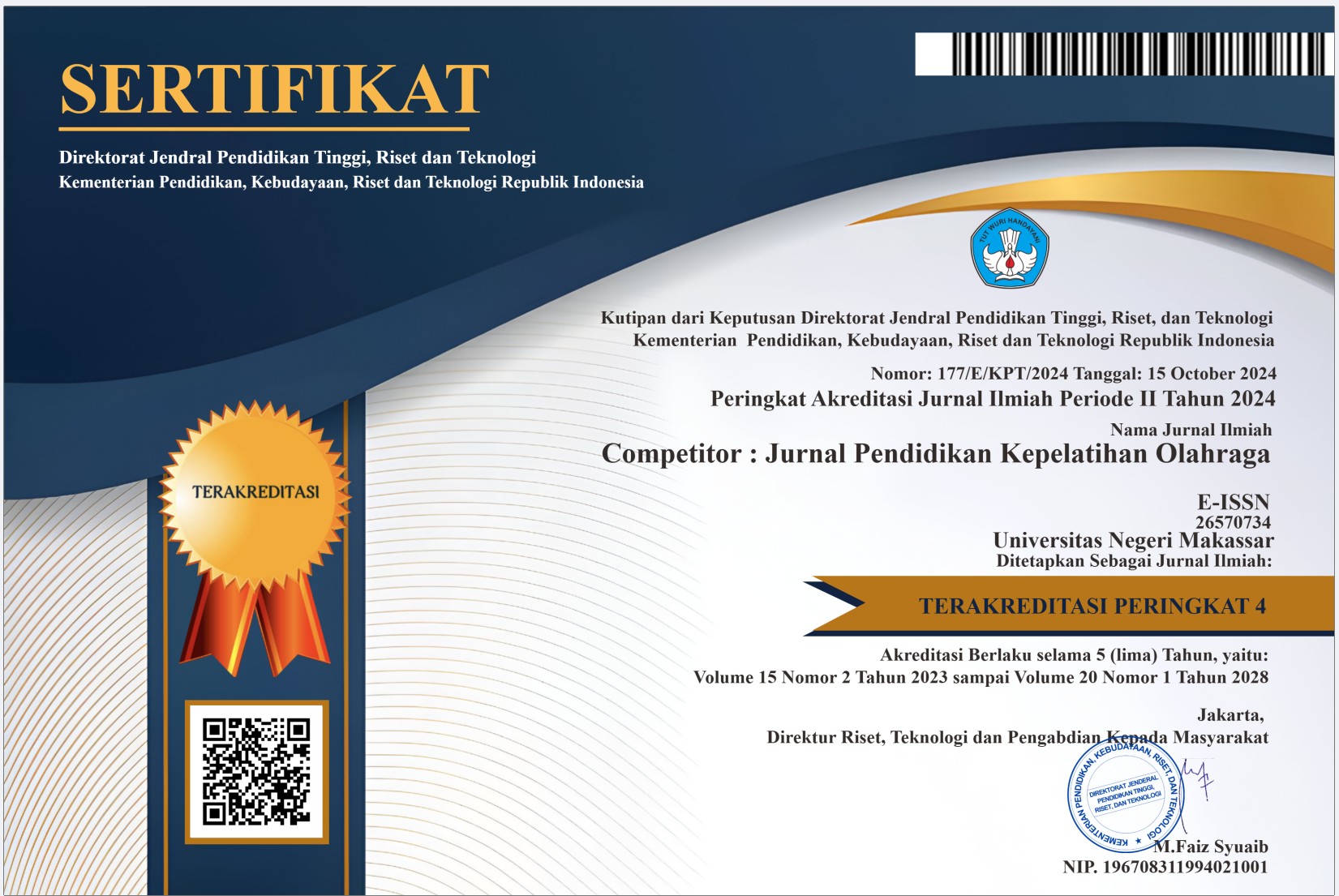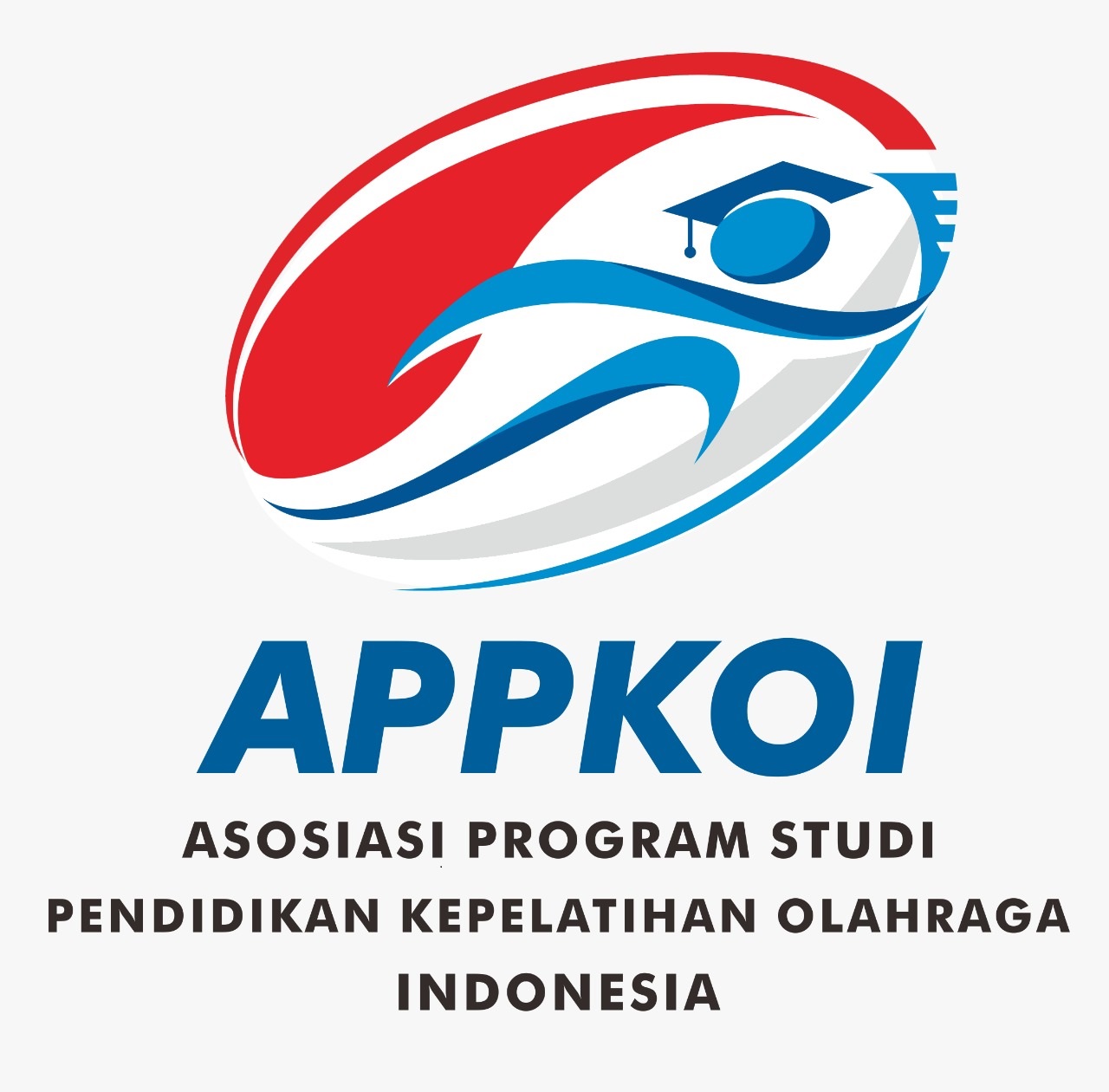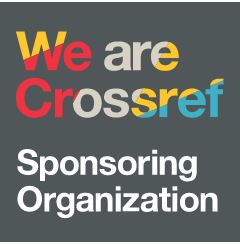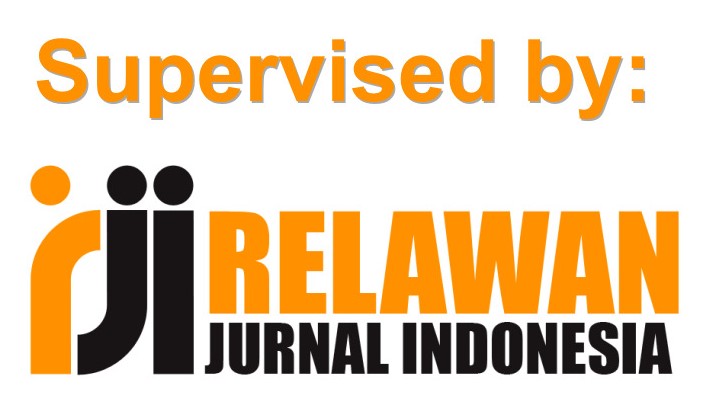Physical Education Teachers' Perceptions of Inclusive Learning in Elementary Schools, Martapura District
DOI:
https://doi.org/10.26858/cjpko.v17i2.73786Keywords:
Inclusive Education, Physical Education, Teacher Perception, Elementary School, Martapura District.Abstract
This study aims to explore the perceptions of Physical Education (PE) teachers toward inclusive learning in elementary schools within Martapura District. Employing a quantitative descriptive method, data were gathered through a 4-point Likert scale questionnaire distributed to 13 PE teachers selected purposively from 7 elementary schools. Participants were chosen based on having a minimum of one year of experience in teaching inclusive classes. The total population encompassed 39 elementary schools in the district. The results revealed a limited understanding of inclusive education among teachers, with 38% indicating inadequate knowledge of its concepts. Similarly, 38% of the respondents fell into the low category in terms of readiness and ability to deliver inclusive Physical Education. A significant proportion of teachers (77%) reported encountering substantial barriers in implementing inclusive learning, such as insufficient training, lack of supporting facilities, and the absence of specialised co-teachers. Despite these challenges, the study found that institutional support—particularly from school principals and inclusive-oriented policies—was relatively strong, with 46% of respondents reporting a high level of school-based backing, albeit with variations across institutions. These findings suggest that while policy-level support exists, the implementation of inclusive PE remains inconsistent and underdeveloped. The study concludes that enhancing inclusive Physical Education requires targeted teacher training programs, better infrastructural support, and stronger collaboration among educators, administrators, and policymakers. Strengthening these components is essential to realise the full potential of inclusive education in fostering equal participation for all students in Physical Education settings.
References
Ainscow, M. (2005). Developing inclusive education systems: what are the levers for change? Journal of Educational Change, 6(2), 109–124. https://doi.org/10.1007/s10833-005-1298-4
Ainscow, M., & Miles, S. (2008). Making education for all inclusive: Where next? Prospects, 38(1), 15–34. https://doi.org/10.1007/s11125-008-9055-0
Amiruddin, M. Z., Widihastrini, F., & Bektiningsih, K. (2021). Pelayanan Pendidikan Bagi Anak Berkesulitan Belajar Di Sekolah Inklusi. Prosiding Penelitian Pendidikan Dan Pengabdian., 1223–1236.
Ani, J., Lumanauw, B., & Tampenawas, J. L. A. (2021). Pengaruh Citra Merek, Promosi Dan Kualitas Layanan Terhadap Keputusan Pembelian Konsumen Pada E-Commerce Tokopedia Di Kota Manado. The Influence of Brand Image, Promotion and Service Quality on Consumer Purchase Decisions on Tokopedia E-Commerce in Manado. 663 Jurnal EMBA, 9(2), 663–674.
Arifin, M., & Sudrajat, A. (2020). Implementation of an inclusive curriculum in physical education. Journal of Physical Education and Sport Sciences, 10(3), 211–219.
Arriani, F., D. (2022). Pendidikan Inklusif. Panduan Pelaksanaan Pendidikan Inklusif.
Asrulla, Risnita, Jailani, M. S., & Jeka, F. (2023). Populasi dan Sampling (Kuantitatif), Serta Pemilihan Informan Kunci (Kualitatif) dalam Pendekatan Praktis. Jurnal Pendidikan Tambusai, 7(3), 26320–26332.
Basuki, I., & Hidayat, R. (2019). Adaptation strategies of PE teachers for students with disabilities. Jurnal Ilmu Keolahragaan, 18(2), 90–99.
Block, M. E., & Obrusnikova, I. (2007). Inclusion in physical education: A review of the literature from 1995–2005. Adapted Physical Activity Quarterly, 24(2), 103–124. https://doi.org/10.1123/apaq.24.2.103
Block, M. E., Taliaferro, A., & Moran, T. (2013). Physical activity and youth with disabilities: Barriers and supports. Preventing Chronic Disease, 10, E107. https://doi.org/10.5888/pcd10.120275
Borges, S. (2023). Perception of Physical Education Teachers about the Inclusion of Students with Special Needs. Global Journal of Human-Social Science, 23(11), 71–75. https://doi.org/10.34257/gjhssgvol23is11pg71
Grenier, M. (2011). Examining differences in perceptions of inclusion between physical education teachers and adapted physical education specialists. Remedial and Special Education, 32(4), 245–254. https://doi.org/10.1177/0741932510361247
Haegele, J. A., Wilson, W. J., Zhu, X., Bueche, J. J., Brady, E., & Li, C. (2021). Barriers and facilitators to inclusion in integrated physical education: Adapted physical educators’ perspectives. European Physical Education Review, 27(2), 297–311. https://doi.org/10.1177/1356336X20944429
Handayani, L., & Rizal, M. (2020). Attitudes of elementary teachers toward inclusive education: A case study in urban Jakarta. Indonesian Journal of Educational Research, 8(2), 110–119.
Haffyandi, R. A., Kahri, M., & Ganeswara, R. O. (2025). Online physical education (olpe) and its influence on high school students’ life skills. Multilateral: Jurnal Pendidikan Jasmani Dan Olahraga, 24(1), 18–31.
Healy, S., Msetfi, R., & Gallagher, S. (2013). Teachers' attitudes toward teaching students with special educational needs in mainstream secondary schools: A large-scale survey in Ireland. European Journal of Special Needs Education, 28(3), 229–243.
Krismayadi, I. W., Sofyan, S., & Rahmadi, R. (2021). Kriteria Penilaian Guru Pendidikan Jasmani Aspek Psikomotor Pada Sekolah Dasar Mitra Jpok Fkip Ulm. STABILITAS: Jurnal Pendidikan Jasmani Dan Olahraga, 2(1), 12–17. https://doi.org/10.20527/mpj.v2i1.1048
Kurniawati, D., & Judisseno, R. K. (2022). Penggunaan Skala Likert Untuk Menganalisa Efektivitas Registrasi Stakeholder Meeting: Exhibition Industry 2020. Seminar Nasional Riset Terapan Administrasi Bisnis , 142–152.
Kurniawan, R., Sunaryo, S., & Nisa, S. (2021). The effectiveness of inclusive training programs for PE teachers. Jurnal Olahraga dan Prestasi, 17(1), 45–55.
Lieberman, L. J., Lepore, M. P., & Houston-Wilson, C. (2017). Strategies for Inclusion: A Handbook for Physical Educators. Human Kinetics.
Lubna, dkk. (2021). Buku Ajar Pendidikan Inklusi.
Makbul, M. (2021). Metode Pengumpulan Data dan Instrumen Penelitian. 75(17), 399–405. https://doi.org/https://doi.org/10.31219/osf.io/svu73
Morley, D., Bailey, R., Tan, J., & Cooke, B. (2005). Inclusive physical education: Teachers’ views of including pupils with special educational needs and/or disabilities in physical education. European Physical Education Review, 11(1), 84–107.
Mutia, M., Warni, H., & Sarmidi, S. (2019). Peran Guru Pendidikan Jasmani Dalam Menanamkan Karakter Keapada Peserta Didik Di Sd Negeri Atu-Atu Kecamatan Pelaihari Kabupaten Tanah Laut. Multilateral Jurnal Pendidikan Jasmani Dan Olahraga, 18(2), 120–125. https://doi.org/10.20527/multilateral.v18i2.7623
Putri, E. A., Subagya, Y., & Ramli, M. (2022). Implementation of inclusive education in elementary schools: Challenges and opportunities. Journal of Education and Learning, 16(1), 33–42.
Qi, J., & Ha, A. S. (2012). Inclusion in physical education: A review of literature. International Journal of Disability, Development and Education, 59(3), 257–281.
Rojo-Ramos, J., Manzano-Redondo, F., Adsuar, J. C., Acevedo-Duque, Á., Gomez-Paniagua, S., & Barrios-Fernandez, S. (2022). Spanish Physical Education Teachers’ Perceptions about Their Preparation for Inclusive Education. Children, 9(1), 1–11. https://doi.org/10.3390/children9010108
Salasiah, Rahmadi, & Irianto, T. (2020). Instrumen Penilaian Harian Aspek Kognitif Pendidikan Jasmani Olahraga Dan Kesehatan. Stabilitas: Jurnal Pendidikan Jasmani Dan Olahraga, 1(1), 25–31. https://doi.org/10.20527/mpj.v1i1.476
Setyaningsih, R., Mariza, A., Hastuti, L. S., Harahap, S. A., Puspitosari, A., Parinduri, S. A., & Prasetyaningsih, R. H. (2021). Tahta Media Group.
Setiawan, H., Susanto, H., & Yulianti, K. (2021). Inclusive education and teacher preparedness in Indonesia. International Journal of Instruction, 14(2), 365–378.
Sharma, U., & Sokal, L. (2015). The impact of a teacher education course on pre‐service teachers’ beliefs about inclusion: An international comparison. Journal of Research in Special Educational Needs, 15(4), 276–284.
Sriyanto, A. (2019). Teknik Pengolahan Hasil Penentuan Standar Asesmen, Teknik Pengolahan dengan Menggunakan Pendekatan Acuan Patokan (PAP) dan Acuan Norma (PAN). Jurnal Al-Lubab, 5(2), 242–258.
Suyatno, S., Rohman, A., & Mulyani, S. (2021). Inclusive physical education: Teachers' experience in implementing inclusive practices. Jurnal Pendidikan Jasmani Indonesia, 17(2), 152–164.
UNESCO. (2017). Education for Sustainable Development Goals: Learning Objectives. Paris: UNESCO.
Vickerman, P., & Coates, J. K. (2009). Trainee and recently qualified physical education teachers’ perspectives on including children with special educational needs. Physical Education and Sport Pedagogy, 14(2), 137–153.
Wahyudi, W. (2022). Analisis Motivasi Belajar Siswa Dengan Menggunakan Model Pembelajaran Blended Learning Saat Pandemi Covid-19 (Deskriptif Kuantitatif Di Sman 1 Babadan Ponorogo). KadikmA, 13(1), 68. https://doi.org/10.19184/kdma.v13i1.31327
Wilhelmsen, T., & Sørensen, M. (2017). Inclusive physical education: A systematic review of empirical studies. Scandinavian Journal of Educational Research, 61(6), 701–722.
Yusnita, D., & Sutarto, E. (2022). Exploring the perception of inclusive education among rural primary teachers. Jurnal Pendidikan Dasar Nusantara, 9(1), 12–21.
Downloads
Published
Issue
Section
License
Copyright (c) 2025 Rahma Azizah, Rahmadi Rahmadi, Recky Ahmad Haffyandi (Author)

This work is licensed under a Creative Commons Attribution 4.0 International License.

